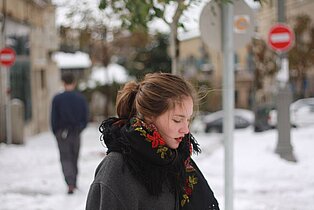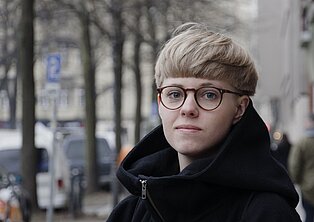Blog 03
Since our last report, we have been busy helping to organise and attending a whole range of events. ARCH+ features 38 took place on 14 May, with Ralph Eue and Florian Wüst presenting their DVD “The Modern City”. The two film curators presented films from the 1950s and 1960s which looked at a wide range of issues relating to modern urban development and residential construction. For example, “Für einen Platz an der Sonne” (“For a Place in the Sun”) by Rudi Hornecker (1959) makes the case for the positive developments that arose from industrial mass production following the Second World War. By contrast, the television film “Die gemordete Stadt” (“Murdered City”) by Manfred Durniok (1965) – which is based on themes discussed in Wolf Jobst Siedler’s book of the same name – warns of the risk of monotony resulting from this development. “Bau 60” (“Building 60”) by Dieter Lemmel (1961) is an experimental film which combines aesthetic shots of a construction site with an almost melodic composition of the sounds recorded there. After the presentation, the two guests discussed the films with Anh-Linh Ngo and Nikolaus Kuhnert from ARCH+ and Joachim Krausse, who made a series of films about building houses for workers for the broadcasting service WDR in the 1970s.
As our work analysing the architecture in Flanders draws to a close, we had the opportunity to take part in the press conference for the reopening of the Berlinische Galerie on 27 May. Curator Ursula Müller gave us a guided tour of “Radically Modern”, a new exhibition presenting planning strategies and designs related to Berlin’s post-war modernism, which is often perceived in a negative light. The 1960s produced ground-breaking urban development concepts and unique pieces of architecture which are now in danger of being forgotten. The aim of the exhibition is not to glorify this decade, but to encourage a sensitive approach to this architectural heritage, as many noteworthy examples have already fallen victim to thoughtless destruction. The important thing about this exhibition is that it displays projects from West Berlin and East Berlin alongside one another. This makes the differences between the two sides of the divided city clear, but also highlights many unmistakable parallels.
On 29 May, we visited the Spreefeld project in Berlin with the ARCH+ team. Florian Köhl, the architectural firm BAR Architekten, Silvia Carpaneto, and Christian Schöning showed us around, giving us an exceptionally detailed and personal insight into their work. The Spreefeld project is an attempt to rejuvenate the idea of cooperatives in residential construction, which has a long tradition in Berlin, with new residential concepts and collectively curated communal areas. This has resulted in homes of varying sizes for families or people living in a house-share arrangement. Instead of being privatised, some of the commercial premises on the ground floors are looked after by cooperative members who use them for projects on a specific theme. They give interesting initiatives an opportunity to carry out their projects at particularly favourable rates. This system has also been used to set up a workshop for self-build initiatives and a type of canteen. We were particularly impressed by the modular ground plans, large outdoor spaces, and the actual implementation process. This process attests to the close collaboration between the individual architects, who have prevailed against the standardised construction of large cooperatives and have managed to pull off a project of this magnitude.
ARCH+ features 39, which will take place on 11 June at the Haus der Kulturen der Welt (“House of the Cultures of the World”), will be dedicated to a similar subject. This event is being held to launch the “Wohnungsfrage” (“Housing question”) project, which will be presented by curators Jesko Frezer, Nikolaus Hirsch, Wilfried Kuehn, and Hila Peleg, along with other key people, over the course of the evening. With a series of publications, a public programme, an international academy, and a concluding exhibition in October, the instigators are hoping to stimulate cross-discipline debate on the social significance of residential construction. The aim is to consider residential construction as an identity-defining building assignment and the scene of everyday life, not just as an economic problem, but in relation to social reality too.
Once we have reopened the Nieves Zines exhibition in the ARCH+ Studio at the Kunst-Werke Institute for the TYPO Berlin design conference, the ARCH+ displays series will continue with an event on 18 June. In the ROOM OF MANIFESTOES, WAI Architecture Think Tank will demonstrate the (potential) value of manifestoes as a tool for engaging critically with contemporary architecture. The architectural firm, which is based in Beijing but was founded by architects from Puerto Rico and France, works in a wide range of fields relating to architecture, urbanism, and architectural research. Featuring a selection of self-published books, magazines, models, collages, and videos, the exhibition will provide an insight into their intentions, ambitions, fears, and desires.





